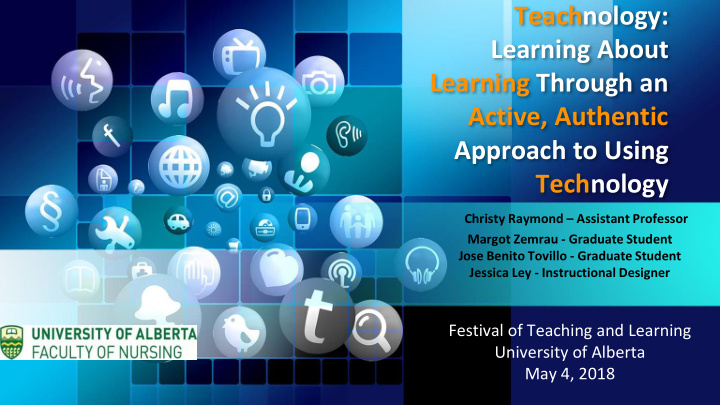



Teachnology: Learning About Learning Through an Active, Authentic Approach to Using Technology Christy Raymond – Assistant Professor Margot Zemrau - Graduate Student Jose Benito Tovillo - Graduate Student Jessica Ley - Instructional Designer Festival of Teaching and Learning University of Alberta May 4, 2018
Road Map • Setting the Scene • Collaborative Partnerships • Student Reactions and Responses • Thoughts for the Future • Discussion
Setting the Scene Course Assignment, Goals and Desired Outcomes ● Teaching Technology Project ● Teaching Technology Celebration Technology as Content and Process Not just learn “about” technology but learning “about” and “with”. ●
Defining the Terms Active Learning - a range of “instructional activities involving students in doing things and thinking about what they are doing” (Bonwell and Eison, 1991, p.5) Experiential Learning - Lewis and Williams (1994, p.5): “In its simplest form, experiential learning means learning from experience or learning by doing. Experiential education first immerses learners in an experience and then encourages reflection about the experience to develop new skills, new attitudes, or new ways of thinking.” Authentic Assessment - “an assessment requiring students to use the same competencies or combinations of knowledge, skills, and attitudes that they need to apply in the criterion situation in professional life” (Gulikers et al, p. 69)
...from a focus on covering decontextualized knowledge to an emphasis on teaching for a sense of salience… (Benner, Sutphen, Leonard & Day, 2009, p. 82) Students like to distinguish between the classroom and the real world, and if you interact with students only in the classroom, you reinforce this false dichotomy (Bowen, 2012, p. 136)
Technology in our Context • Teaching & Learning Office, Faculty of Nursing • Technology Toolbox • Authentic Technology Projects
You Want Us To Do What??? • First thoughts (Apprehensions) • Awakening a Passion • Fostering Curiosity • Gaining a Critical Confidence
Pondering the Possibilities: Student Reflection
So Where To Now? • Looking Back – What are the things that could have been done differently? • Looking Forward – What questions can we continue to ask to study interventions and ideas such as these?
Thought Sharing and ?s • How can active learning be actualized in different contexts? • What principles of active learning, experiential learning and authentic assessment overlap and how can we create synergy between these components to inspire our students and energize our learning environments? • How do we create more evidence to support authentic, active and experiential approaches to learning?
References Ashford-Rowe, K., Herrington, J., & Brown, C. (2014). establishing the critical elements that determine authentic assessment. Assessment & Evaluation in Higher Education, 39(2), 205-222. Benner, P. Sutphen, M., Leonard, V., & Day, L. (2010). Educating nurses: A call for radical transformation. Stanford, CA: Carnegie Foundation for the Advancement of Teaching. Jossey-Bass. Bonwell, C. C., and Eison, J.A. (1991). Active learning: creating excitement in the classroom. ASH#-ERIC Higher Education Report No. 1, Washington, D.C.: The George Washington University, School of Education and Human Development.owen. Bowen, J.A. (2012) Teaching naked: How moving technology out of your college classroom will improve student learning. San Francisco, CA: Jossey-Bass. Cullen, R., Harris, M., & Hill, R.R. (2012). The Learner-centered curriculum: Design and implementation. San Francisco, CA: Jossey-Bass. Fink, L.D. (2013). Creating significant learning experiences: An integrated approach to designing college courses. San Francisco, CA: Jossey-Bass. Freeman, S., Eddy, S.L., McDonough, M., Smith, M.K., Okorafor, N., Jordt, H., and Wenderoth, M.P., (2014). Active learning increases student performance in science, engineering, and mathematics. Proceedings of the National Academy of Sciences (PNAS), 111 (23), 8410-8415. Lewis, L.H. & Williams, C.J. (1994). In Jackson, L. & Caffarella, R.S. (Eds.). Experiential Learning: A New Approach (pp. 5-16). San Francisco: Jossey-Bass Poindexter, K., Hagler, D., & Lindell, D. (2015). Designing authentic assessment: Strategies for nurse educators. Nurse Educator, 40(1), 36-40. Schwartz, M (2012). Best practices in experiential learning. Ryerson University: Learning and Teaching Office. Retrieved from http://www.ryerson.ca/It Weimer, M. (2018). Deeper thinking about active learning. Faculty Focus Blog retrieved February28m 2018 from https://www.faculty focus.com/articles/teaching- professor-blog/deeper-thinking-active-learning
Contact Christy Raymond RN, PhD Assistant Professor Faculty of Nursing, University of Alberta 780-248-5769 or craymond@ualberta.ca
Recommend
More recommend